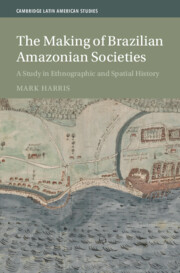Refine search
Actions for selected content:
626 results

The Making of Brazilian Amazonian Societies
- A Study in Ethnographic and Spatial History
-
- Published online:
- 14 November 2025
- Print publication:
- 20 November 2025
The politics of ‘green’ finance as knowledge contestations
-
- Journal:
- Finance and Society ,
- Published online by Cambridge University Press:
- 13 November 2025, pp. 1-13
-
- Article
-
- You have access
- Open access
- HTML
- Export citation
Just Hanging Around: A Pilot Study Investigating Children’s Knowledge of Grey-Headed Flying-Foxes and the Feasibility and Impact of a Peer-Designed Educational Intervention
-
- Journal:
- Australian Journal of Environmental Education , First View
- Published online by Cambridge University Press:
- 05 November 2025, pp. 1-11
-
- Article
-
- You have access
- Open access
- HTML
- Export citation
Effects of Disaster Triage Training Program on Knowledge, Skills, and Resilience Among Nurses: A Randomized Controlled Trial
-
- Journal:
- Disaster Medicine and Public Health Preparedness / Volume 19 / 2025
- Published online by Cambridge University Press:
- 17 October 2025, e298
-
- Article
- Export citation
Conclusion
-
- Book:
- Kierkegaard and the Structure of Imagination
- Published online:
- 26 September 2025
- Print publication:
- 16 October 2025, pp 248-256
-
- Chapter
- Export citation
7 - Building Generalizable Theory from Transcultural Ethnographies
- from Part II - Transcultural Ethnography
-
- Book:
- Ethnography in International Business
- Published online:
- 21 October 2025
- Print publication:
- 09 October 2025, pp 166-185
-
- Chapter
- Export citation
6 - Knowledge, Technology Transfer and Convergence
-
- Book:
- An Economic History of Europe
- Published online:
- 02 October 2025
- Print publication:
- 02 October 2025, pp 132-154
-
- Chapter
- Export citation
High ceilings and ingenuine allies: tapping into the idiom meaning knowledge of first and second language speakers of English
-
- Journal:
- Language and Cognition / Volume 17 / 2025
- Published online by Cambridge University Press:
- 18 September 2025, e72
-
- Article
-
- You have access
- Open access
- HTML
- Export citation
3 - Black Catholic Knowledge in the Caribbean
- from Part II - Religion in Place
-
- Book:
- Black Catholic Worlds
- Published online:
- 28 August 2025
- Print publication:
- 11 September 2025, pp 125-161
-
- Chapter
- Export citation
Chapter 4 - Understanding the Flaws of Experience and Memory
-
- Book:
- Knowledge Doesn't Exist and Other Thoughts on Critical Thinking
- Published online:
- 22 October 2025
- Print publication:
- 21 August 2025, pp 46-62
-
- Chapter
- Export citation
Chapter 3 - Knowledge Doesn’t Exist
-
- Book:
- Knowledge Doesn't Exist and Other Thoughts on Critical Thinking
- Published online:
- 22 October 2025
- Print publication:
- 21 August 2025, pp 32-45
-
- Chapter
- Export citation
Chapter 6 - The World Is a Book
-
- Book:
- How the World Became a Book in Shakespeare's England
- Published online:
- 09 August 2025
- Print publication:
- 14 August 2025, pp 191-233
-
- Chapter
- Export citation
Dietary beliefs, knowledge and behaviour of NZ South Asians at risk for cardiovascular disease.
-
- Journal:
- Proceedings of the Nutrition Society / Volume 84 / Issue OCE2 / June 2025
- Published online by Cambridge University Press:
- 24 July 2025, E180
-
- Article
-
- You have access
- Export citation
A qualitative investigation into the essential knowledge and skills for early career nutritionists in New Zealand
-
- Journal:
- Proceedings of the Nutrition Society / Volume 84 / Issue OCE2 / June 2025
- Published online by Cambridge University Press:
- 24 July 2025, E164
-
- Article
-
- You have access
- Export citation
When it is (and is not) Blameworthy to Break the Rules
-
- Journal:
- Episteme , First View
- Published online by Cambridge University Press:
- 18 July 2025, pp. 1-14
-
- Article
-
- You have access
- Open access
- HTML
- Export citation
Conceptualising knowledge governance: knowledge regimes and institutions
-
- Journal:
- Journal of Institutional Economics / Volume 21 / 2025
- Published online by Cambridge University Press:
- 16 July 2025, e28
-
- Article
-
- You have access
- Open access
- HTML
- Export citation
5 - How Does Knowledge Shape Ideas?
-
- Book:
- Innovation Management
- Published online:
- 06 June 2025
- Print publication:
- 10 July 2025, pp 54-70
-
- Chapter
- Export citation
Competence and confidence of health care professionals in using clozapine: a qualitative systematic review and thematic synthesis
-
- Journal:
- Acta Neuropsychiatrica / Volume 37 / 2025
- Published online by Cambridge University Press:
- 30 June 2025, e73
-
- Article
-
- You have access
- Open access
- HTML
- Export citation
Dark Emu and Indigenous Studies
- Part of
-
- Journal:
- Public Humanities / Volume 1 / 2025
- Published online by Cambridge University Press:
- 27 June 2025, e109
-
- Article
-
- You have access
- Open access
- HTML
- Export citation
Experiences of Absence that Get the World Right
-
- Journal:
- Episteme , First View
- Published online by Cambridge University Press:
- 24 June 2025, pp. 1-19
-
- Article
-
- You have access
- Open access
- HTML
- Export citation
